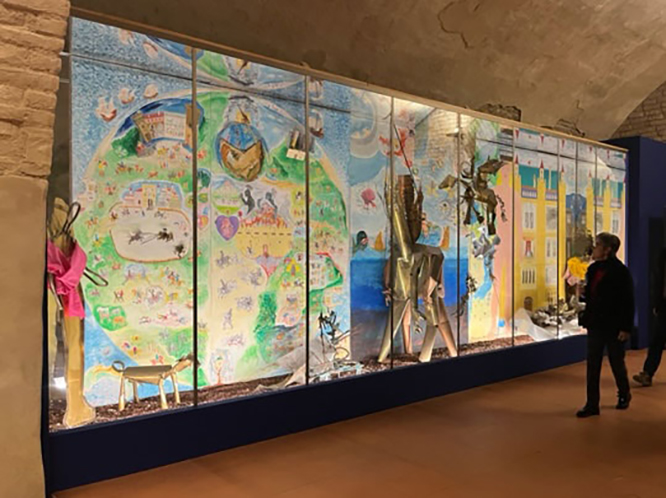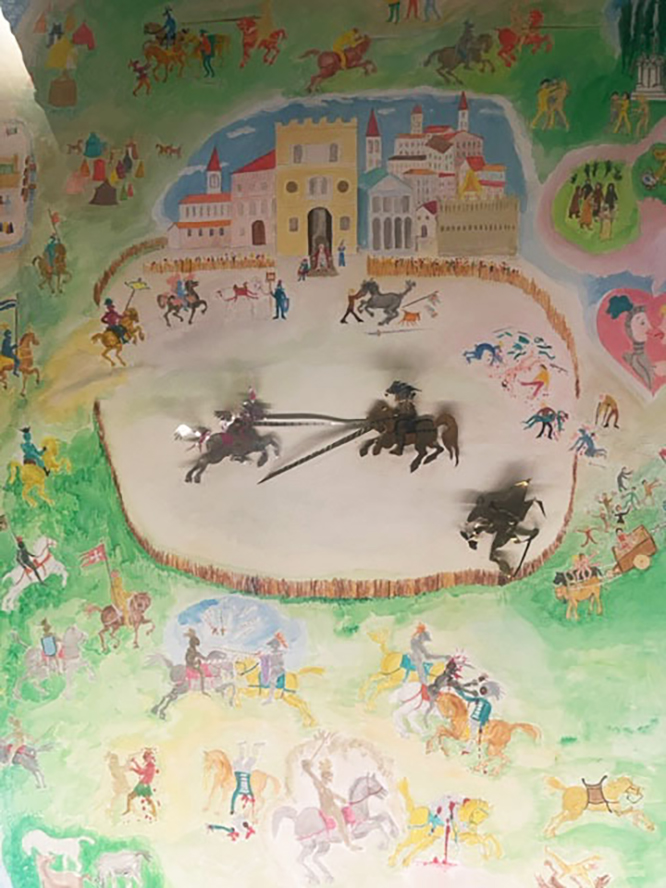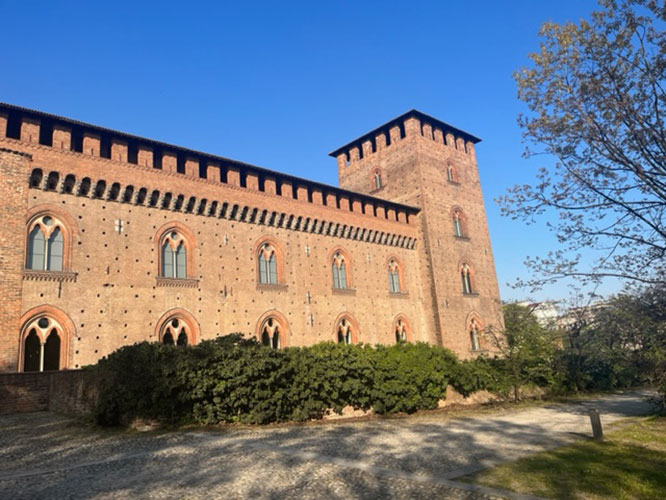
On April 10, 2025, at 6:00 p.m., the Civic Museums of Pavia at the Castello Visconteo will reopen with a large, new installation on Orlando Furioso by Alik Cavaliere, curated by Francesca Porreca.
This large-scale sculptural work is inspired by Ludovico Ariosto’s Renaissance epic. It is prominently displayed at the museum entrance, inviting visitors into a world where literature and sculpture intertwine.
Orlando Furioso by Alik Cavaliere: A Fusion of Literature and Sculpture
The imposing work (more than 7 meters long) will remain on loan to the Civic Museums for a long time. The work gives tangible and scenographic life to Ludovico Ariosto’s poem with the irony and narrative skill.
Cavaliere’s Orlando Furioso captures the essence of Ariosto’s narrative through intricate forms and dynamic compositions. The installation reflects the tumultuous adventures of the poem’s characters, translating the literary fervor into a tangible, visual experience. This work exemplifies Cavaliere’s ability to merge storytelling with sculptural innovation, offering viewers a multidimensional interpretation of the classic text.



Celebrating Cultural Heritage in a Historic Venue
The reopening of the Scuderie del Castello Visconteo marks a significant moment for Pavia’s cultural scene. By showcasing Cavaliere’s Orlando Furioso, the museum honors a pivotal literary work and reaffirms its commitment to celebrating Italian artistic heritage. The exhibition invites visitors to explore the intersections of history, literature, and contemporary art within the storied walls of the Castello Visconteo.
Cavaliere’s large installation will become a testimonial for the renovated spaces of the Civic Museum, together with a pirogue from the 4th century BC: past and present to embrace a cultural proposal by the Municipality of Pavia. It aims to enhance the historical-artistic heritage and offer to young people an interactive classroom, large panels with reproductions of single-lancet, double-lancet, and four-lancet windows on mirrored surfaces, a space with models of the castle and a video on its history made by Karmachina.

Engaging the Community Through Art
In conjunction with the exhibition, the Musei Civici di Pavia has organized educational activities centered around Cavaliere’s Orlando Furioso. These programs aim to deepen public engagement with the artwork and its literary origins, fostering a dialogue between past and present.
The exhibition is open to the public. It offers an opportunity to experience Cavaliere’s masterful interpretation of a literary classic within a historical setting.
For more information please refer to the official channels of the Musei Civici di Pavia.
Only until September 10, however, will it be possible to compare it with the other large installation by Cavaliere on Orlando Furioso present at the Alik Cavaliere Art Center via De Amicis 17 in Milan (for opening hours, see the website www.alikcavaliere.it.
About Alik Cavaliere
Alik Cavaliere (1926–1998) was an Italian sculptor renowned for his imaginative and unconventional approach to art. Born in Rome to poet Alberto Cavaliere and Russian-Jewish sculptor Fanny Kaufmann, he spent his early years between Rome and Paris before settling in Milan in 1938. There, he studied at the Brera Academy under notable artists like Francesco Messina, Giacomo Manzù, Achille Funi, and Marino Marini, eventually succeeding Marini as the chair of sculpture in 1970.
Cavaliere’s work defied categorization, as he chose not to align with any specific art movement. Instead, he explored themes of life, freedom, nature, and history. His sculptures are crafted from diverse materials, including bronze, wood, fabric and found objects. His installations have often the form of intricate labyrinths. These invite viewers to engage in a personal journey without a definitive perspective.
Throughout his career, Cavaliere participated in several prestigious exhibitions, including multiple appearances at the Venice Biennale, where he had solo rooms in 1964 and 1972. His notable works include “I processi dalle storie inglesi di W. Shakespeare” (1972) and “I giardini della memoria” (1988–1990). His legacy continues to influence contemporary art, with his pieces housed in various public and private collections.
The series of works on the theme of Orlando Furioso (1993-4), is today at the MART in Rovereto, and his last great work, Grande Albero, unfinished, is in the cloister of the Conservatory of Milan.











